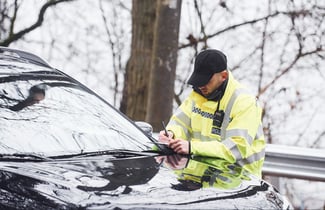Omicold AB together with the developer of "Method of linen", Percold AB, was hired after a number of police officers in Norrbotten expressed a wish to improve and winter-adapt the protective clothing used by the police. The assignment was to initially give tips on winter boots with greater resistance to cold, but also as a supplement to implement the concept Method of Linnaeus for the police in Norrbotten.
The concept includes:
- A survey that finds out the underlying causes of possible cold sensitivity
- A knowledge-raising lecture with the aim of raising knowledge about the effect of cold on humans
- How to improve the conditions and prevent future injuries
- A test where the individual's own conditions are measured
The questionnaire identifies the underlying causes of possible disabilities, such as diseases that affect the ability to circulate blood, problems related to impaired circulation and work-related causes.
The goal is to optimize winter ability for police officers in Sweden with a focus on subarctic conditions by increasing their awareness of dangers and risks in their daily work, increase their ability to handle emergencies, create longer endurance and reduce / alleviate injuries and thus increase general safety for himself and his work team.
Introductory lecture on winter ability and the measurement method "Method of Linnaeus" is held at local workplaces in Luleå, Kalix, Haparanda, Piteå, Gällivare and Kiruna, attended by representatives from management, the union, operational staff with long experience and new employees as well as representatives from occupational health care.
When the project started, a test group consisting of 6 women and 15 men was selected for individual tests of "cold sensitivity". Of these, 17 were tested, 5 women and 12 men. During the test sessions in Luleå and Kalix, another 7 tests were performed by people who also wanted to be tested (mixed outdoor staff and office staff), thus 25 people were tested (11 women and 14 men).


The results of the tests gave two courses; "Warm hands" and "cold hands". Warm hands refer to hands that recover quickly to the original temperature before the cold provocation because cold hands only recover 1 to 1.5 degrees at the fingertips. Women generally have lower hand temperatures compared to men and they recover more slowly after a cold provocation. A large proportion of the test subjects have impaired recovery ability, especially in the fingertips, which can be linked back to e.g. use of protective gloves against stab wounds that contain materials that dissipate heat from the hands.
The evaluation shows that the lectures have generally met the participants' expectations, but that an in-depth, but more police-oriented education is required, preferably interspersed with internships and testing of personal equipment.
Thus, there are great opportunities for improving the working environment by raising skills, developing the right protective equipment and monitoring (through, for example, annual tests of the ability to circulate in the hands and feet) that the staff's health does not deteriorate.